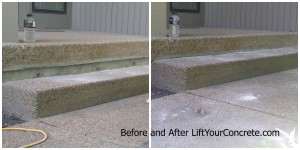This is a question we’ve seen posted on the internet. The answers we found for fixing sinking front steps were surprising. We’ve been in the foam jacking business since 2013. Our knowledge of how to build homes goes back even further. And what we saw online could only have come from someone with limited knowledge of how to fix this problem accurately. That is the challenge when trying to do research online. You have a question, and you search for answers on Google. You believe you have found the answer when you find what you are searching for. Because the information you find online must be accurate, right? We now know that the searches are filled with inaccurate information and unknowledgeable opinions.
How to fix sinking front steps

This is a great example of what we can do if your front steps are sinking!
So here is the question: Our front entry steps are concrete and have sunken about six inches over the years. What are the options for fixing the sinking front steps? Here are the answers that we found:
- rip them all out and build them again
- dig underneath and jack it up, pour a new footer and set it back down
- leave it and build something over the top
- pry it up with a big bar and shove some bricks and stone dust under it using a jack for a car, dig down a bit, and jack up the front to make it level.
- Place a large pressure-treated beam underneath it for support, and then remove the jack.
Wow. Those answers were pretty shocking to us. These solutions are nowhere in the ballpark of what could and should be done with sinking concrete steps. As a consumer, how do you know what to do when your search results come up with these answers?
As experts in the field of concrete lifting and sinking steps, you can find your answer here.
If you need more information on how to evaluate what you find while searching online, keep reading.
Three things to do to authenticate the information you find online
Tip #1 Check the date of the information
People using the internet for information and tips don’t check the date the information was posted. If the information is a few years old, chances are the information is old as well. Technology and solutions can change with time. Ensure you have the most up-to-date information available for your search. Also, follow up with any links you find. Knowledgeable articles should also have a link to the company or individual that wrote it. Then follow the links. Are they qualified to answer the question? Do they have experience in the area? Read the reviews that are on the site. Do they appear to be an expert in the field or someone throwing 2 cents into the mix?
Tip #2: Keep searching for other solutions that make sense
When posing a query online, use your common sense. If something seems a bit far-fetched to you, move on, and locate information that seems more palatable. In this case, prying a step up and shoving bricks underneath it to lift it into place is not a solution that warrants much consideration. If the information seems amiss, refer to Tip #1. You’ll find the information is probably old or the source unreliable and inexperienced at best. Trust yourself and keep looking!
Tip #3: Talk to experts in the field for validation
In this situation, once you gather your information, find reliable sources to check your facts. A good concrete raising expert will want to look at your sinking concrete steps in person or will ask you to send photos. A concrete-raising expert will be able to educate you about their solution and provide a detailed estimate for the work. Ask for referrals and visit their website. Make sure you do business with a company that can back up their work. It’s always best to go with a person you trust and a company that has been in business for a while. These are indicators that the job will be done right the first time.
Internet searches have moved from being a search engine to an answer engine. But take care to run down the answers you do find online with local experts. The internet may be able to point you in the right direction, but a good expert will be able to get you there with confidence!
This article was originally posted in June 2015 and has been updated.





